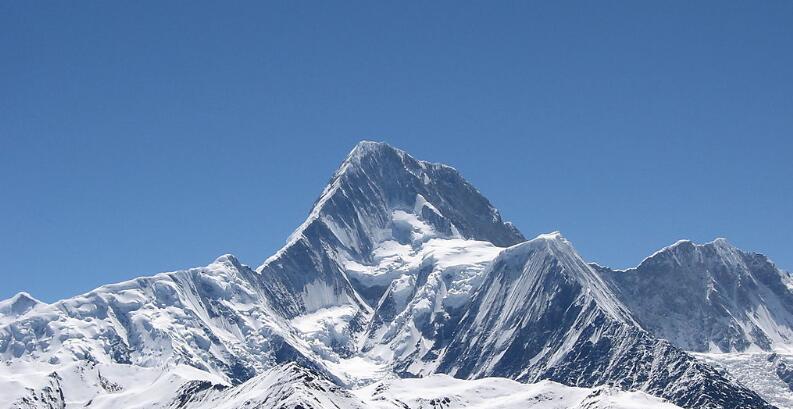Gongga Mountain in Tibetan means”pure white mountain” and is considered a sacred place in the snow-covered plateau area. It is also called “the king of mountains in Sichuan”, with a length of 60km from its north to south, and a width of 30km from its east to west. The main peak has an elevation 0f7,556m.The Gongga National Nature Reserve is one of the largest national nature reserves in China as it crosses over Kangding county Jiulong county Loding county and Shimian county encompassing over 409,143.5 hectares. Due to its location in the transition zone of Qinghai-Tibetan Plateau and Sichuan basin, Gongga National Nature Reserve plays an important role in aerography, geography,biology science of mountain environment, and tourism, attracting great attention from researchers and scientists Rom all over the world.
The large altitude disparity between Gongga Mountain and the surrounding areas is unique in
Sichuan and internationally From the main peak to the eastward slope at the Moxi river outlet itis only 2.9km, whereas the altitude disparity is 6,466m. The great elevation differences, the complicated landforms, and the fluctuating climate have created optimal growing conditions formultiple ecosystems. 7he forest ecological system includes sub-alpine dark coniferous forest, mixed coniferous broadleaf forest, Zhongshan coniferous forest, coniferous forest in lower mountains,evergreen broadleaf forest, and sclerophyllous evergreen broadleaf forest. The alpine scrub ecological system mainly appears between 3,600m and 4,300m above sea level and connects the alpine meadow and the coniferous forest. The alpine meadow ecological system is primarily found at 4,LOOM-4,800m above sea level. It can be easily found in watershed and gully areas, is widely distributed, and connects alpine scree with the forest line.
While the alpine scree ecological system is mostly distributed between 4,600m-5,200m above the sea level, connecting the line of firs above it is the monsoon thawing Zone, and the weather there is terrible.
The vegetation belts in Gongga Nature Reserve are complex as there are 14 vegetation types, 67 formations, 151 familia, 688 genera, and 2,472 species. Of these, 26 kinds are non-vascular plants (bryophyte), 123 are ferns, 33 ale different seed-producing plants (gymnospenn), and 2,290 are types of flowering plants (angiosperm). There are also 3 kinds of National First Level Protected Plant,the Chenese Yew or taxus chinwsis, Marie’s Yew or taxus mairei, and the endemic perennial
herbs or kingdonia unfora. As well there are 10 kinds of National Second Level Protected Plants and 260 usable plant types.
This diverse ecological environment provides wild animals with optimal habitats. There are 97 kinds of Mammalia, belonging to 7 different orders and 26 familia. There are 27 kinds of rodents and 26 different carnivores. Of these, 27 are National Protected Mammalia, and 9 are National First Level Protected Mammalia. They are giant pandas, Sichuan snub-nosed monkey leopard, clouded leopard,snow leopard, forest musk deer, alpine musk deey takin, and white-lipped deer. 18 kinds of National Second Level Protected Mammalia, such as Tibetan macaque, Rhesus macaque, dhole, red panda, Asiatic black bear, Lutra, serow, Naemorhedus goral,among many others.
There are also several kinds of birds in the reserve, about 17 different orders] 52 familia, and
326 species. In which, there are Passeriformes of 29 familial 232 species, including 6 kinds Of National First Level Protected birds, they are golden eagle, white-tailed sea eagle, Gypaetus barbatus,Chinese hazel grouse, buff-throated partridge,and Phasianus versicolor. There also are Non-passeriformes of 22 familial 94 species, 27 kinds of National Second Level Protected birds, and 14 kinds of wild birds native to China.
Gongga Mountain is also a famous alpine tourism spot. The majestic Gongga peak is surrounded by 45 mountains, which are 6,000m above sea level. 17% of the mountain area is at an altitude of over 51000m. They are the most dangerous, different, and magnificent alpines in the Hengduan Mountain region of the Qnghai-Tibet Plateau.
The most remarkable scenery is the glacial ecosystem. There are 74 glaciers in this reserve, with an area of 255km2. These glaciers originate from both sides of the mountain range, spread like the wings of birds. Yanzi Valley is the largest glacier, with an area of 32.07km2, and a length of 10.5km, Mozi Valley has a length of 11.6km,and an area of26.84krn2. Both are valley glaciers.
Hailuo Valley the glacier valley on the east slope of the Gongga main peak, has a length of 30.7km. It is listed as a national scenic spot, a national forest, and a national geopark. The charming Gongga attracts tourists from all over the world because of its mysterious and ancient forest, the
beautiful azaleas, sun kissed mountains, relaxing hot springs, and the majestic frozen waterfalls.
Besides mountains and glaciers, there are plenty of mountain lakes in the Gongga Nature Reserve: Lieta Lake, Renzong Lake, Bawang Lake,just to name a few. The deep blue and aquamarine waters make the lakes look like jade deposits throughout the mountains.
Researchers have worked hard and placed infrared cameras throughout the Gongga Nature Reserve to capture pictures of the wild animals in their natural habitats. With more knowledge of what animals are living in the Gongga and how important they are to the ecosystem, the public
can appreciate and advocate for maintaining their natural habitats.












